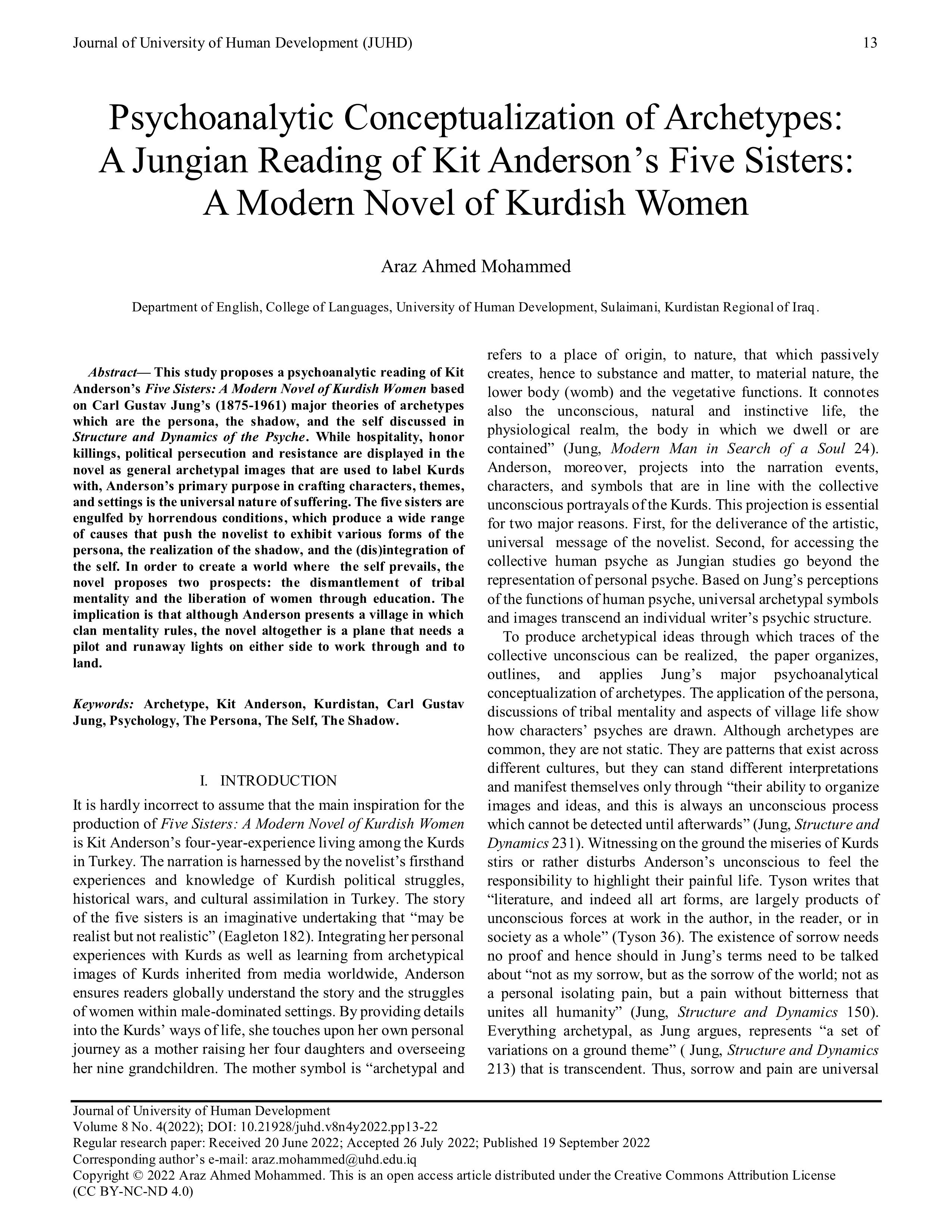Psychoanalytic Conceptualization of Archetypes
A Jungian Reading of Kit Anderson’s Five Sisters: A Modern Novel of Kurdish Women
DOI:
https://doi.org/10.21928/juhd.v8n4y2022.pp13-22Keywords:
Archetype, Kit Anderson, Kurdistan, Carl Gustav Jung, Psychology, The Persona, The Self, The ShadowAbstract
This study proposes a psychoanalytic reading of Kit Anderson’s Five Sisters: A Modern Novel of Kurdish Women based on Carl Gustav Jung’s (1875-1961) major theories of archetypes which are the persona, the shadow, and the self discussed in Structure and Dynamics of the Psyche. While hospitality, honor killings, political persecution and resistance are displayed in the novel as general archetypal images that are used to label Kurds with, Anderson’s primary purpose in crafting characters, themes, and settings is the universal nature of suffering. The five sisters are engulfed by horrendous conditions, which produce a wide range of causes that push the novelist to exhibit various forms of the persona, the realization of the shadow, and the (dis)integration of the self. In order to create a world where the self prevails, the novel proposes two prospects: the dismantlement of tribal mentality and the liberation of women through education. The implication is that although Anderson presents a village in which clan mentality rules, the novel altogether is a plane that needs a pilot and runaway lights on either side to work through and to land.
References
Anderson, Kit. Five Sisters: A Modern Novel of Kurdish Women. 1st Ed. 2012. Print.
Barry, Peter. Beginning Theory: An Introduction to Literary and Cultural Theory. Manchester, UK: Manchester University Press, 2009. Print.
Brifkani, Zaid. The Mountains We Carry. 1st Ed. 2021. Print.
Eagleton, Terry. How to Read Literature, New Haven: Yale University Press, 2013.
Frankl, Viktor E. Man's Search for Meaning: An Introduction to Logotherapy. New York: Simon & Schuster, 1984. Print.
Fromm, Erich. The Art of Loving. New York: Perennial Library, 1989. Print.
Gladwell, Malcolm. Outliers: The Story of Success. Little, Brown and Company, 2008, New York.
Jung, C G, and Marie-Luise . Franz. Man and His Symbols. New York: Dell Pub. Co, 1964. Print.
Jung, C G. Aion; Researches into the Phenomenology of the Self. 1959. Print.
Jung, C. G. (Gerhard Adler & R. F. C. Hull, Trans.). Collected works of C. G. Jung: Vol. 8. Structure and Dynamics of the Psych. Princeton University Press, 1969. Print.
Jung, C. G. The Archetypes and the Collective Unconscious. Translated by R. F. C. Hull, 2nd ed., Routledge, 1991.
Jung, C. G., and W. S. Dell. Modern Man in Search of a Soul. Translated by W. S. Dell and Cary F. Baynes, Harcourt Publishers Group, 1955.
Peterson, Jordan B, Norman Doidge, and Sciver E. Van. 12 Rules for Life: An Antidote to Chaos. 2018. Print.
Shetty, Jay. Think Like a Monk: Train Your Mind for Peace and Purpose Every Day. Simon and Schuster, 2020.
Tyson, Lois. Critical Theory Today: A User-Friendly Guide. New York: Routledge, 2006. Print.
Yousafzai, Malala. We are Displaced: My Journey and Stories from Refugee Girls around the World. Weidenfeld & Nicolson, 2019..

Downloads
Published
How to Cite
Issue
Section
License
Copyright (c) 2022 Araz Ahmed Mohammed Mohammed

This work is licensed under a Creative Commons Attribution-NonCommercial-NoDerivatives 4.0 International License.


